|
|
|
Sort Order |
|
|
|
Items / Page
|
|
|
|
|
|
|
| Srl | Item |
| 1 |
ID:
175486
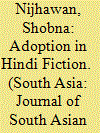

|
|
|
|
|
| Summary/Abstract |
This article examines gendered lives in vernacular fiction by focusing on the topic of child adoption as fictionalised in Hindi literature in late colonial India (1920s). It argues that non-conformance and non-normativity dominated the short stories selected for this article. The feature of non-conformance towards normative assumptions in middle-class Hindu society also concerned Hindi literary realism of the time more generally, especially when presenting a diversity of intergenerational relationships between women, men, children and youth within the family setting, as well as beyond. The narratives discussed here show how social norms set by caste, class, gender, religion and biology were surpassed when it came to imagined family constellations in the late colonial period.
|
|
|
|
|
|
|
|
|
|
|
|
|
|
|
|
| 2 |
ID:
177197


|
|
|
|
|
| Summary/Abstract |
This essay offers a reading of advertisements of wearable technologies, or prostheses, designed to enhance sexual pleasure and physical health in Tibbi Dunya Lahore, an Urdu-language medical periodical. It contrasts the conception of the body implicit in these advertisements with that of earlier medieval and early modern discourses on sex. This juxtaposition of historically disparate discourses renders visible the colonial transformations of sexual subjectivity that Urdu print advertising presents. By juxtaposing these medical advertisements with earlier medico-moral discourses, one can see a shift away from technologies of the self, directed at managing the interiority of desire, towards the consumption of ‘small technologies’ that exteriorise pleasure. This material suggests not only the mutual implication of ars erotica and scientia sexualis, but also the subversion of both by the commodification of pleasure.
|
|
|
|
|
|
|
|
|
|
|
|
|
|
|
|
| 3 |
ID:
174138
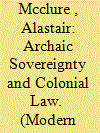

|
|
|
|
|
| Summary/Abstract |
The judicial and summary punishment of whipping—absent from the Indian Penal Code (IPC) of 1860—was passed into law through Act No. VI of 1864. This legislation, tacked on as an appendage to the IPC, invested the judge with wider discretionary powers to administer violence across Indian society. In this case what emerged was an evolving attempt to enlarge the colonial state's capacity for quotidian violence, targeting certain bodies to reaffirm, manage, and police the social hierarchies upon which colonial sovereignty depended. In the context of a slow imperial movement away from the cast-iron distinctions that had been made between groups in the early nineteenth century—distinctions that had, among other things, supported a legally enforced system of slavery—new methods to mark the value of different bodies were created. The events of the 1850s, in particular the rebellion of 1857–1858, saw the re-emergence of the colonial idea that certain bodies could withstand violence, and that violence itself could be used to create economically productive colonial societies, in debates around penal law and punishment. This article will trace this history through formal legal restrictions and informal legal-cultural practices in relation to corporal punishment in colonial India. Over the course of the period under study, this legislation introduced into law what one official termed ‘the category of the “whippable”’.1 Charting the changing shape of this legal category along lines of race, gender, caste, class, and age, the article will argue that a logic of exceptionality, channelled here through the application of judicial violence, attempted to structure and manage Indian society in complicated ways.
|
|
|
|
|
|
|
|
|
|
|
|
|
|
|
|
| 4 |
ID:
093088
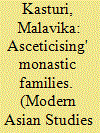

|
|
|
|
|
| Publication |
2009.
|
| Summary/Abstract |
This paper examines a fundamental premise of Anglo-Hindu law on succession between 1860 and 1940, that kinship was emblematic of secular modes of living, to analyse its implications for the assertion of masculinity within ascetic orders in northern India. Legal discourses engaged with rights to succession within ascetic orders, by functioning on the assumption that the renunciatory life of ascetics was antithetical to sexuality and domesticity. This institutionalization of law, that defined asceticism and fixed ascetic masculinities within a legal frame, occurred with the consent of ascetic orders concerned with the ownership and distribution of property, even though sexuality and gender played a central role in shaping relationships within sacred spaces. Myriad ties embracing the language of kinship shaped ascetic orders. Bonds of sentiment and sexual attachment over-lapped with, sustained, and produced the bonds tying spiritual preceptors to their disciples. Relationships within ascetic families, consisting of men, their female companions, children and relatives, along with their attendant obligations were validated through rights of ownership and inheritance to property. Taking advantage of Anglo-Hindu law by the early twentieth century, ascetic orders sought to 'purify' their genealogies through the medium of property disputes fought in colonial courts. By manipulating the legal meanings ascribed to asceticism, masculinity and renunciation, these orders effaced unwanted members from their orders with varying degrees of success, especially women and children.
|
|
|
|
|
|
|
|
|
|
|
|
|
|
|
|
| 5 |
ID:
132961
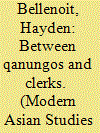

|
|
|
|
|
| Publication |
2014.
|
| Summary/Abstract |
This paper argues that our understanding of the transition to colonialism in South Asia can be enriched by examining the formation of revenue collection systems in north India between 1750 and 1850. It examines agrarian revenue systems not through the prism of legalism or landholding patterns, but by looking at the paper and record-based mechanisms by which wealth was actually extracted from India's hinterlands. It also examines the Kayastha pensmen who became an exponentially significant component of an Indo-Muslim revenue administration. They assisted the extension of Mughal revenue collection capabilities as qanungos (registrars) and patwaris (accountants). The intensity of revenue assessment, extraction and collection had increased by the mid 1700s, through the extension of cultivation and assessment by regional Indian kingdoms. The East India Company, in its agrarian revenue settlements in north India, utilized this extant revenue culture to push through savage revenue demands. These Kayastha pensmen thus furnished the 'young' Company with the crucial skills, physical records, and legitimacy to garner the agrarian wealth which would fund Britain's Indian empire. These more regular patterns of paper-oriented administration engendered a process of 'bureaucratization' and the emergence of the modern colonial state.
|
|
|
|
|
|
|
|
|
|
|
|
|
|
|
|
| 6 |
ID:
152622
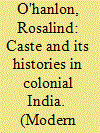

|
|
|
|
|
| Summary/Abstract |
David Washbrook's influential early work on South India set the terms for much subsequent debate about caste, with its exploration of the key role of the colonial state in shaping caste ideologies and institutions. Over subsequent decades, historians and anthropologists have come increasingly to emphasise the ‘colonial construction’ of caste and its enduring legacies in post-colonial India. Yet there were also significant continuities linking the forms of colonial caste with much earlier regional histories of conflict and debate, whose legacies can be traced into the late colonial period. In particular, the juxtaposition between Brahman and non-Brahman itself was anticipated in a tradition of conservative social commentary that emerged in the Deccan Sultanate state of Ahmadnagar, and came to circulate widely through Banaras and western India during the seventeenth and eighteenth centuries. This tradition of commentary acquired new salience during the nineteenth century. It entered the colonial archive as an authoritative source of knowledge, and also provoked early ‘non-Brahman’ intellectuals into a fresh engagement with its conservative social vision. In their attempts to rebut this vision, these intellectuals displayed a detailed knowledge of its social history and a deep familiarity with the judicial decisions through which it had been upheld in earlier centuries.
|
|
|
|
|
|
|
|
|
|
|
|
|
|
|
|
| 7 |
ID:
080310
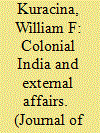

|
|
|
|
|
| Publication |
2007.
|
| Summary/Abstract |
This essay relates the Indian National Congress's struggle against British imperialism to the global politics of the mid-1930s. While contextualizing the Congress's anti-colonialism as a world view intending to combat imperial systems of exploitation, this article postulates that the foreign policy of the post-colonial Indian state originated in the Congress's anti-imperialism and anti-fascism of the 1930s. Drawing on published sources that chart policy decisions and illustrate the attitudes of leading actors in the formulation of official policy, this article hypothesizes that the principles generated by inter-war exigencies proved to be incompatible ideologies for the construction of India's post-colonial foreign policy
|
|
|
|
|
|
|
|
|
|
|
|
|
|
|
|
| 8 |
ID:
102752
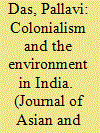

|
|
|
|
|
| Publication |
2011.
|
| Summary/Abstract |
Much of the deforestation seen in the Himalayas today can be traced back to the second half of the 19th century when railway construction began in colonial India. In this paper I argue that the construction and expansion of railways promoted by the British colonial state was designed to enable efficient resource extraction from India and that this process itself depleted India's natural resources such as forests. In analysing the temporal and spatial unevenness of this deforestation in the specific context of the Punjab province I have drawn on government records of various departments, Parliamentary reports, books, scientific journals and newspapers as primary sources.
|
|
|
|
|
|
|
|
|
|
|
|
|
|
|
|
| 9 |
ID:
181680
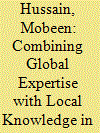

|
|
|
|
|
| Summary/Abstract |
This article traces the evolution of branded commodity advertising and consumption from corporeal health concerns to the racialisation of beauty through skin-lightening cosmetics in late colonial India. It centres two empirical foci: the marketing of personal hygiene products to Indian markets, and their racialised and gendered consumption. This article argues that the imperial economy tapped into and commodified ideals of cleanliness, beauty and fairness through marketing—ideals that continue to pervade contemporary South Asian communities. Contrary to claims that multinational corporations permeated Indian markets after the economic liberalisation of the late 1980s, there is a much deeper genealogy to the racialised imperial economy operating in European colonies. This article also examines the phenomenological underpinnings of imperial whiteness in colonial encounters to demonstrate how certain commodities appealed to Indians as ‘modern’ consumers, as well as how middle-class Indians and local entrepreneurs became active participants in the demand for, consumption and production of personal hygiene commodities.
|
|
|
|
|
|
|
|
|
|
|
|
|
|
|
|
| 10 |
ID:
098925
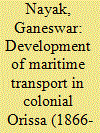

|
|
|
| 11 |
ID:
118908
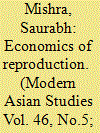

|
|
|
|
|
| Publication |
2012.
|
| Summary/Abstract |
The expansionist policies of the early colonial regime led to a significant emphasis on the importance of a large cavalry, but horses of a suitable quality appeared difficult to obtain within the subcontinent. Several measures were consequently taken to encourage horse-breeding, including the establishment of government studs and policies directed towards the creation of a 'native' market in quality horses. However, these measures did not appear to produce any significant results, despite sustained implementation. This paper examines in detail colonial policies on horse-breeding and links them to the larger economic logic of empire. It touches on several related themes such as early colonial interaction with 'native' agents, the question of free markets, and the impact of utilitarian and physiocratic doctrines on colonial policies.
|
|
|
|
|
|
|
|
|
|
|
|
|
|
|
|
| 12 |
ID:
004284
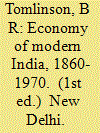

|
|
|
|
|
| Edition |
1st ed.
|
| Publication |
New Delhi, Cambridge University Press, 1993.
|
| Description |
xvii, 235p.: figures, maps, tableshbk
|
| Series |
New Cambridge History of India; 3
|
| Standard Number |
8185618216
|
|
|
|
|
|
|
|
|
|
|
|
Copies: C:1/I:0,R:0,Q:0
Circulation
| Accession# | Call# | Current Location | Status | Policy | Location |
| 034956 | 954/TOM 034956 | Main | On Shelf | General | |
|
|
|
|
| 13 |
ID:
163815
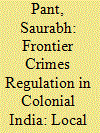

|
|
|
|
|
| Summary/Abstract |
In their pursuit of self-serving goals, sometimes governments create and use various instruments as the means to relatively short-term ends. Such instruments, however, can be tenacious, and have perverse, long-lasting impacts. This paper focuses on one such instrument created during the British Raj: the Frontier Crimes Regulation. Often, the literature on the Regulation focuses on the rationale for its creation from the perspective of the colonisers and refers to the long-term consequences in hindsight, thereby ignoring local voices. However, I show that in 1901, at the time of the drafting of the Regulation, the local colonised population foresaw the potentially lasting pernicious effects stemming from it and voiced their concerns. I demonstrate that these local voices can help us understand the roots of the problems in the Federally Administered Tribal Areas (FATA) of Pakistan today.
|
|
|
|
|
|
|
|
|
|
|
|
|
|
|
|
| 14 |
ID:
087782
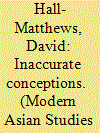

|
|
|
|
|
| Publication |
2008.
|
| Summary/Abstract |
From the 1870s onwards, debates about famine policy were central to both colonial and nationalist conceptions of the role, effectiveness and legitimacy of the state in India. Although opinions on how best to relieve famines varied, ideological opposition to a narrow laissez-faire paradigm was given short shrift in the years preceding the formulation of the Indian Famine Codes. However, specific empirical critiques of the making and implementing of famine policy were more effective. This article explores the ways in which such challenges put scientific and statistical experts within the colonial edifice at odds with those at the top of the political hierarchy, focusing on disputes over relief wages and famine mortality calculations between Sir Richard Temple and Surgeon-Major W. R. Cornish. It further examines how proto-nationalist groups and newspapers seized on the value given to statistics by the state to hold it to account for its failure to relieve famine.
|
|
|
|
|
|
|
|
|
|
|
|
|
|
|
|
| 15 |
ID:
107058
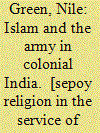

|
|
|
|
|
| Publication |
New Delhi, Cambridge University Press, 2009.
|
| Description |
xvi, 217p.
|
| Series |
Cambridge studies in Indian history and society ; 16
|
| Standard Number |
9780521762717, hbk
|
|
|
|
|
|
|
|
|
|
|
|
Copies: C:1/I:0,R:0,Q:0
Circulation
| Accession# | Call# | Current Location | Status | Policy | Location |
| 056202 | 954.0088297/GRE 056202 | Main | On Shelf | General | |
|
|
|
|
| 16 |
ID:
094014
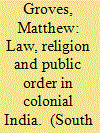

|
|
|
|
|
| Publication |
2010.
|
| Summary/Abstract |
Throughout history expanding imperial powers have consistently cast themselves as reluctant but dutiful policemen-bringers of peace and order to the periphery. The British were no exception. In India, however, the vaunted Pax Britannica was limited and patchy. While not exactly a myth, it never quite matched either the roseate claims made of it in official propaganda or the jingoistic perceptions of the masses at home.
|
|
|
|
|
|
|
|
|
|
|
|
|
|
|
|
| 17 |
ID:
144225
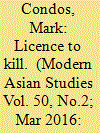

|
|
|
|
|
| Summary/Abstract |
In 1867, the Government of India passed one of the most brutal-minded and draconian laws ever created in colonial India. Known as the ‘Murderous Outrages Act’, this law gave colonial officials along the North-West Frontier wide powers to transgress India's legal codes in order to summarily execute and dispose of individuals identified as ‘fanatics’. Arguments for the creation and preservation of this law invariably centred around claims about the purportedly ‘exceptional’ character of frontier governance, particularly the idea that this was a region that existed in a perpetual state of war and crisis. Far from being peripheral in its impact, this article explores how this law both drew upon and enabled a wider legal culture that pervaded India in the wake of 1857. It argues that this law was a signal example of British attempts to mask the brute power of executive authority through legalistic terms, and was also evocative of a distinctly ‘warlike’ logic of colonial legality.
|
|
|
|
|
|
|
|
|
|
|
|
|
|
|
|
| 18 |
ID:
175481
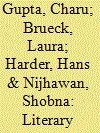

|
|
|
|
|
| Summary/Abstract |
This collection brings together nine essays, accompanied by nine short translations, that redraw the boundaries of literary histories both temporally and spatially. The essays, rooted in the humanities and informed by interdisciplinary area studies, explore multiple linkages between forms of print culture, linguistic identities and diverse vernacular literary spaces in colonial and post-colonial South Asia. The essays and translations foreground complex and politicised expressions of gender and genre in fictional and non-fictional print materials and thus draw meaningful connections between the vernacular and literature, the everyday and the marginals, and gender and sentiment. Collectively, they expand vernacular literary archives, canons and genealogies, and push us to theorise the nature of writing in South Asia.
|
|
|
|
|
|
|
|
|
|
|
|
|
|
|
|
| 19 |
ID:
089881


|
|
|
|
|
| Publication |
2009.
|
| Summary/Abstract |
This paper discusses shifts within Islamic life, ritual and practice in the town of Amroha in the United Provinces of India, during the eventful period of approximately 1860-1930. Based primarily upon Urdu writings produced about or by Muslim residents of the town during this period, it examines the ways in which wider religious reformist movements such as those associated with Aligarh, Deoband and Bareilly were received and experienced within nearby smaller, supposedly marginal urban settlements. The paper argues that broader currents of religious reform were not unquestioningly accepted in Amroha, but were often engaged in a constant process of dialogue and accommodation with local particularities. The first section introduces Amroha and its sharif Muslim population, focusing upon how the town's Islamic identity was defined and described. The second section examines a plethora of public religious rites and institutions emerging during this period, including madrasas and imambaras, discussing how these were used by eminent local families to reinforce distinctly local hierarchies and cultural particularities. A third section considers public debates in Amroha concerning the Aligarh movement, arguing that these debates enhanced local rivalries, especially those between Shia and Sunni Muslims. A final section interrogates the growing culture of religious disputation in the town, suggesting that such debate facilitated the negotiation of religious change in a transitory social environment
|
|
|
|
|
|
|
|
|
|
|
|
|
|
|
|
| 20 |
ID:
188846
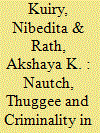

|
|
|
|
|
| Summary/Abstract |
Nineteenth-century colonial India witnessed the much-hyped anti-thuggee campaign, instrumental in creating an elaborate archive of frequent commentaries, opinions on banditry, prisoners and their trials, approvers’ accounts, administrative studies as well as fictional narratives. Re-reading such archival sources, this article explores how nautch, a hybrid form of dance, once glorified and later criminalised by the colonial powers, became a point of intersection between the Europeans in India and local thugs, who often benefitted from such dancers. The article shows the precarious position of the nautch performers as instrumental in collaborating with the colonial rulers and the outlawed thugs for controlling perceived ‘crime’ in the Indian subcontinent, while ending up as victims, too.
|
|
|
|
|
|
|
|
|
|
|
|
|
|
|
|
|
|
|
|
|